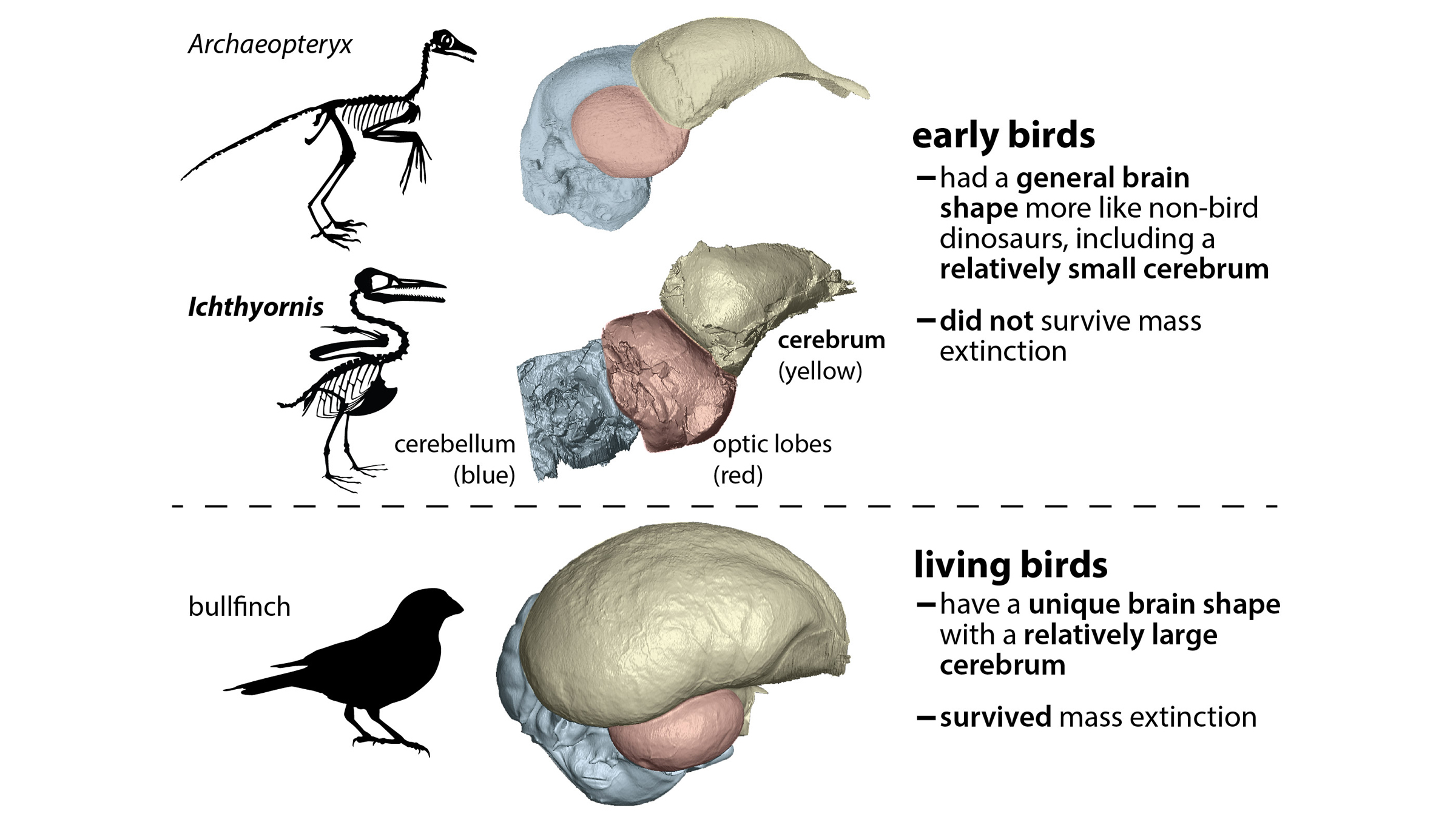How did birds survive the dinosaur-killing asteroid?
Many bird lineages went extinct, but some survived.

When the dinosaur-killing asteroid collided with Earth about 66 million years ago, it triggered a slew of horrific events — shockwaves, wildfires, acid rain, tsunamis, volcanic eruptions and nuclear winter-like conditions — that killed about 80% of all animal species. But, mysteriously, some dinosaurs survived: the birds.
But why did some lineages of birds endure, while others perished? New research on a well-preserved ancient bird skull suggests that the bird species that survived the cataclysm had bigger cerebrums, or forebrains — the front region of the brain.
Although it's not clear exactly how larger forebrains helped birds survive, as the forebrain is responsible for many processes, "it likely had to do with behavioral plasticity — the birds with bigger forebrains could probably modify their own behavior quickly enough to keep up with how quickly their environment was changing," study lead researcher Chris Torres, a National Science Foundation postdoctoral research fellow in the Heritage College of Osteopathic Medicine at Ohio University, told Live Science in an email.
Related: In images: Fossilized dinosaur brain tissue
The study was published online July 30 in the journal Science Advances and was presented online Nov. 2 at the Society of Vertebrate Paleontology's annual conference, which is virtual this year due to the COVID-19 pandemic.
Bird brain
Bird bones are delicate and rarely fossilize well or in three dimensions, meaning that scientists hardly ever get a good look at ancient bird braincases, the interior part of the skull where the brain sat. But a few years ago, researchers found a well-preserved, partially 3D fossil of Ichthyornis, an ancient toothy bird that lived during the Cretaceous period, in a rock formation dating to 87 million to 82 million years ago in Kansas.
"It has a nearly complete skull, which is incredibly rare both for this particular species (Ichthyornis) as well as fossil birds in general," said Torres, who did the research as doctoral student in the Department of Integrative Biology at the University of Texas at Austin. "This new fossil preserves most of the bones that make up the skull, providing us with our first complete looks at many of those bones."
Sign up for the Live Science daily newsletter now
Get the world’s most fascinating discoveries delivered straight to your inbox.
So Torres and his colleagues used X-ray computed tomography (CT) scanning to digitally reconstruct Ichthyornis' facial skeleton and brain structure. An analysis of the brain shape revealed that ancient birds like Ichthyornis had a "old fashioned" brain; its brain was more like the brains of dinosaurs than the brains of living birds.

Living birds have "enormous forebrains relative to the rest of their brains," Torres said. The forebrains of today's birds are large compared with the forebrains of ancient birds and dinosaurs that lived just before the end-Cretaceous mass extinction. Given that Ichthyornis, a very close relative of living birds, still didn't have a big forebrain like living birds do, "we can infer that those big brains evolved in the ancestor of living birds," Torres wrote in the email.
Perhaps this big forebrain gave the ancestor of living birds an evolutionary advantage that helped them survive the "catastrophic global climate change that likely occurred during that mass extinction, which helps explain why only extant [living] birds, and not any other kinds of dinosaurs, managed to survive," Torres said.
However, Ichthyornis's brain did have a surprising feature: a wulst. This structure, previously known only from birds that lived after the mass extinction, is thought to be a visual and sensory processing center that plays a role in flight. The discovery of a wulst in a Mesozoic, or dinosaur-age, bird reveals that ancient bird brains were more complex than previously thought.
The brain structure analysis shows that bird brains didn't evolve in a neat progression over time, but developed as a complex mosaic of brain structures. "It's not a clear linear progression of everything becoming more complex or better adapted," said Jack Tseng, an assistant professor of vertebrate paleontology at the University of California, Berkeley and an assistant curator at its Museum of Paleontology, who was not involved in the study. "There are actually bits and pieces that were added on over time, [in] different combinations."
Originally published on Live Science.

Laura is the archaeology and Life's Little Mysteries editor at Live Science. She also reports on general science, including paleontology. Her work has appeared in The New York Times, Scholastic, Popular Science and Spectrum, a site on autism research. She has won multiple awards from the Society of Professional Journalists and the Washington Newspaper Publishers Association for her reporting at a weekly newspaper near Seattle. Laura holds a bachelor's degree in English literature and psychology from Washington University in St. Louis and a master's degree in science writing from NYU.










